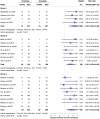Clinical Outcomes of Arthroscopic Tenodesis Versus Tenotomy for Long Head of the Biceps Tendon Lesions: A Systematic Review and Meta-analysis of Randomized Clinical Trials and Cohort Studies
- PMID: 33997057
- PMCID: PMC8071980
- DOI: 10.1177/2325967121993805
Clinical Outcomes of Arthroscopic Tenodesis Versus Tenotomy for Long Head of the Biceps Tendon Lesions: A Systematic Review and Meta-analysis of Randomized Clinical Trials and Cohort Studies
Abstract
Background: Controversy exists concerning whether tenotomy or tenodesis is the optimal surgical treatment option for proximal biceps tendon lesions.
Purpose: To evaluate the clinical outcomes after arthroscopic tenodesis and tenotomy in the treatment of long head of the biceps tendon (LHBT) lesions.
Study design: Systematic review; Level of evidence, 4.
Methods: A systematic review was performed by searching PubMed, the Cochrane Library, Web of Science, and Embase to identify randomized controlled trials (RCTs) and cohort studies that compared the clinical efficacy of tenotomy with that of tenodesis for LHBT lesions. A standardized data extraction form was predesigned to obtain bibliographic information of the study as well as patient, intervention, comparison, and outcome data. A random-effects model was used to pool quantitative data from the primary outcomes.
Results: A total of 21 eligible studies were separated into 3 methodological groups: (1) 4 RCTs with level 1 evidence, (2) 3 RCTs and 4 prospective cohort studies with level 2 evidence, and (3) 10 retrospective cohort studies with level 3 to 4 evidence. Analysis of the 3 groups demonstrated a significantly higher risk of the Popeye sign after tenotomy versus tenodesis (group 1: risk ratio [RR], 3.29 [95% CI, 1.92-5.49]; group 2: RR, 2.35 [95% CI, 1.43-3.85]; and group 3: RR, 2.57 [95% CI, 1.33-4.98]). Arm cramping pain remained significantly higher after tenotomy only in the retrospective cohort group (RR, 2.17 [95% CI, 1.20-3.95]). The Constant score for tenotomy was significantly worse than that for tenodesis in the prospective cohort group (standardized mean difference [SMD], -0.47 [95% CI, -0.73 to -0.21]), as were the forearm supination strength index (SMD, -0.75 [95% CI, -1.28 to -0.21]) and the Simple Shoulder Test (SST) score (SMD, -0.60 [95% CI, -0.94 to -0.27]).
Conclusion: The results demonstrated that compared with tenodesis, tenotomy had a higher risk of a Popeye deformity in all 3 study groups; worse functional outcomes in terms of the Constant score, forearm supination strength index, and SST score according to prospective cohort studies; and a higher incidence of arm cramping pain according to retrospective cohort studies.
Keywords: Biceps; arthroscopic; meta-analysis; tenodesis; tenotomy.
© The Author(s) 2021.
Conflict of interest statement
One or more of the authors has declared the following potential conflict of interest or source of funding: This study was funded by the Beijing Municipal Science and Technology Commission (grant Z171100001017209), National Natural Science Foundation of China (grants 81972130, 81703896, 81972107, 81902203, and 82072494), National Key Research and Development Program of China (grant 2017YFC0108102), and Capital Health Research and Development of Special Fund (grant 2020-2-4067). AOSSM checks author disclosures against the Open Payments Database (OPD). AOSSM has not conducted an independent investigation on the OPD and disclaims any liability or responsibility relating thereto.
Figures













Similar articles
-
Biceps tenotomy versus tenodesis for lesions of the long head of the biceps tendon: A systematic review and meta-analysis of randomized controlled trials.Medicine (Baltimore). 2021 Jan 22;100(3):e23993. doi: 10.1097/MD.0000000000023993. Medicine (Baltimore). 2021. PMID: 33545991 Free PMC article.
-
Biceps Tenodesis Better Improves the Shoulder Function Compared with Tenotomy for Long Head of the Biceps Tendon Lesions: A Meta-Analysis of Randomised Controlled Trials.J Clin Med. 2023 Feb 22;12(5):1754. doi: 10.3390/jcm12051754. J Clin Med. 2023. PMID: 36902540 Free PMC article. Review.
-
Does Biceps Tenotomy or Tenodesis Have Better Results After Surgery? A Systematic Review and Meta-analysis.Clin Orthop Relat Res. 2021 Jul 1;479(7):1561-1573. doi: 10.1097/CORR.0000000000001672. Clin Orthop Relat Res. 2021. PMID: 33617158 Free PMC article.
-
A meta-analysis comparing tenotomy or tenodesis for lesions of the long head of the biceps tendon with concomitant reparable rotator cuff tears.J Orthop Surg Res. 2019 Nov 15;14(1):370. doi: 10.1186/s13018-019-1429-x. J Orthop Surg Res. 2019. PMID: 31729995 Free PMC article.
-
Biceps tenodesis versus tenotomy: a systematic review and meta-analysis of level I randomized controlled trials.J Shoulder Elbow Surg. 2021 May;30(5):951-960. doi: 10.1016/j.jse.2020.11.012. Epub 2020 Dec 26. J Shoulder Elbow Surg. 2021. PMID: 33373685
Cited by
-
Single-Portal Proximal Biceps Tenodesis Using an All-Suture Anchor.Arthrosc Tech. 2022 Mar 16;11(4):e497-e503. doi: 10.1016/j.eats.2021.11.023. eCollection 2022 Apr. Arthrosc Tech. 2022. PMID: 35493056 Free PMC article.
-
The Clinical Outcomes of Arthroscopic Tenotomy versus Tenodesis with Medium-to-Massive Rotator Cuff Tear in the Elderly: A Retrospective Study.Clin Interv Aging. 2025 Jan 9;20:33-42. doi: 10.2147/CIA.S493029. eCollection 2025. Clin Interv Aging. 2025. PMID: 39817259 Free PMC article.
-
Subpectoral, Suprapectoral, and Top-of-Groove Biceps Tenodesis Procedures Lead to Similar Good Clinical Outcomes: Comparison of Biceps Tenodesis Procedures.Arthrosc Sports Med Rehabil. 2023 May 25;5(3):e663-e670. doi: 10.1016/j.asmr.2023.03.007. eCollection 2023 Jun. Arthrosc Sports Med Rehabil. 2023. PMID: 37388890 Free PMC article.
-
The impact of biceps tenotomy/tenodesis on Popeye sign incidence and functional outcome.JSES Int. 2024 Nov 23;9(2):373-379. doi: 10.1016/j.jseint.2024.10.015. eCollection 2025 Mar. JSES Int. 2024. PMID: 40182273 Free PMC article.
-
Biomechanical Analysis of Lark-Loop, Lasso-Loop and Krackow Suture Technique in Tenodesis.Orthop Surg. 2023 Apr;15(4):1136-1143. doi: 10.1111/os.13669. Epub 2023 Feb 27. Orthop Surg. 2023. PMID: 36852476 Free PMC article.
References
-
- Ahmad CS, ElAttrache NS. Arthroscopic biceps tenodesis. Orthop Clin North Am. 2003;34(4):499–506. - PubMed
-
- Belay ES, Wittstein JR, Garrigues GE, et al. Biceps tenotomy has earlier pain relief compared to biceps tenodesis: a randomized prospective study. Knee Surg Sports Traumatol Arthrosc. 2019;27(12):4032–4037. - PubMed
-
- Boileau P, Baque F, Valerio L, Ahrens P, Chuinard C, Trojani C. Isolated arthroscopic biceps tenotomy or tenodesis improves symptoms in patients with massive irreparable rotator cuff tears. J Bone Joint Surg Am. 2007;89:747–757. - PubMed
Publication types
LinkOut - more resources
Full Text Sources

